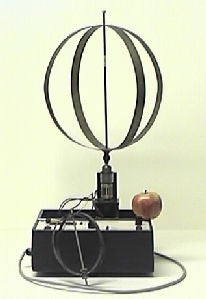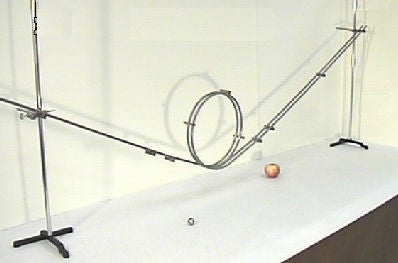M.12(1) – Centripetal Hoops
This apparatus can be used to demonstrate the flattening of the earth’s poles. It consists of two spring metal rings (32 m in diameter for the large one and 10 cm in diameter for the small one) mounted at right angles to one another on a metal axis. The tops of the rings are free to slide along the center axis. The hoops is mounted in the mechanical rotator and set in motion slowly. As the speed is gradually increased, the hoop will visibly flatten.

M.12(2) – Rotator Globe
A glass sphere of about 15 cm in diameter has mercury and tinted pink water sealed in it. The sphere is set in motion slowly. As it rotates, the mercury distributes itself around the sphere’s equator against the glass. The water also has the same distribution, but since it is less dense than mercury, it forms an internal layer. It will distribute itself against the mercury layer. Since there is more water than mercury in the sphere, a person standing away from the apparatus will see a central layer of mercury and two layers of pink water (top and bottom) while the sphere rotates.
This demonstrates that the centripetal force is greater for the more dense substance.

M.12(3) -Loop-the-Loop
A ball rolling on this track demonstrates the relationship among potential, kinetic and rotational energies. Loop-the-loop is a circular section of track with rails of metal tubing held together by metal cross ties. It is attached to two straight sections of similar track. The ends of the cross ties have threads that fit short support rods for use in supporting the track. Release the ball from one end of the track. The ball will orbit the track without losing contact and will reach the other end at the same height as it began.

M.12 (4) Greek Waiter
This experiment consists of a beaker attached to a platform that can be swirled around thanks to a long handle. Some colored water is poured inside the beaker. If the beaker is swirled fast enough, the water stays inside the beaker even when upside down. This is a demonstration of centripetal force, which is an apparent force pointing outwards. This is only an apparent force as it is the water’s inertia that explains why it does not fall out of the beaker.
Click here to see a video of this demo.
